Abstract
Liver content of pentose-cycle intermediates and the activity of the three major cytoplasmic NADPH-producing enzymes and pentose-cycle enzymes were measured in three dietary states: 48 h-starved rats, rats fed on a standard diet ad libitum, and rats meal-fed with a low-fat high-carbohydrate diet. Measured tissue contents of pentose-cycle intermediates in starved liver were: 6-phosphogluconate, 4.7 +/- 0.5 nmol/g; ribulose 5-P, 3.7 +/- 0.5 nmol/g; xylulose 5-P, 4.3 +/- 0.4 nmol/g; sedoheptulose 7-P, 25.5 +/- 1.3 nmol/g; and combined sedoheptulose 7-P and ribose 5-P, 30.6 +/- 0.7 nmol/g. These values were in good agreement with values calculated from fructose 6-P and free glyceraldehyde 3-P, assuming the major transketolase, transaldolase, ribulose-5-P 3-epimerase and ribose-5-P isomerase reactions were all in near-equilibrium. Similar results were found in animals fed ad libitum. These relationships were not valid in animals fed on a low-fat high-carbohydrate diet, with tissue contents of metabolites in some cases being more than an order of magnitude higher than the calculated values. Measured tissue contents of pentose-cycle intermediates in these animals were: 6-phosphogluconate, 124.2 +/- 13.9 nmol/g; ribulose 5-P, 44.8 +/- 7.1 nmol/g; xylulose 5-P, 77.2 +/- 9.4 nmol/g; sedoheptulose 7-P, 129.9 +/- 10.1 nmol/g; and combined sedoheptulose 7-P and ribose 5-P, 157.0 +/- 11.3 nmol/g. In all animals, regardless of dietary state, tissue content of erythrose 4-P was less than 2 nmol/ml. Liver activities of glucose-6-P dehydrogenase and 6-phosphogluconate dehydrogenase were increased from 3.5 +/- 0.9 mumol/g and 7.3 +/- 0.5 mumol/min per g in starved animals to 13.2 +/- 1.1 and 10.5 +/- 0.7 mumol/min per g in low-fat high-carbohydrate-fed animals. Despite these changes, the activities of transaldolase (3.4 +/- 0.3 mumol/min per g), transketolase (7.8 +/- 0.2 mumol/min per g) and ribulose-5-P 3-epimerase (7.5 +/- 0.4 mumol/min per g) were not increased in meal-fed animals above those observed in starved animals (3.4 +/- 0.2, 7.1 +/- 0.3 and 8.6 +/- 0.4 mumol/min per g respectively). The increase in the activity of oxidative pentose-cycle enzymes in the absence of any change in the non-oxidative pentose cycle appeared to contribute to the observed disequilibrium in the pentose cycle in animals meal fed on a low-fat high-carbohydrate diet.
Full text
PDF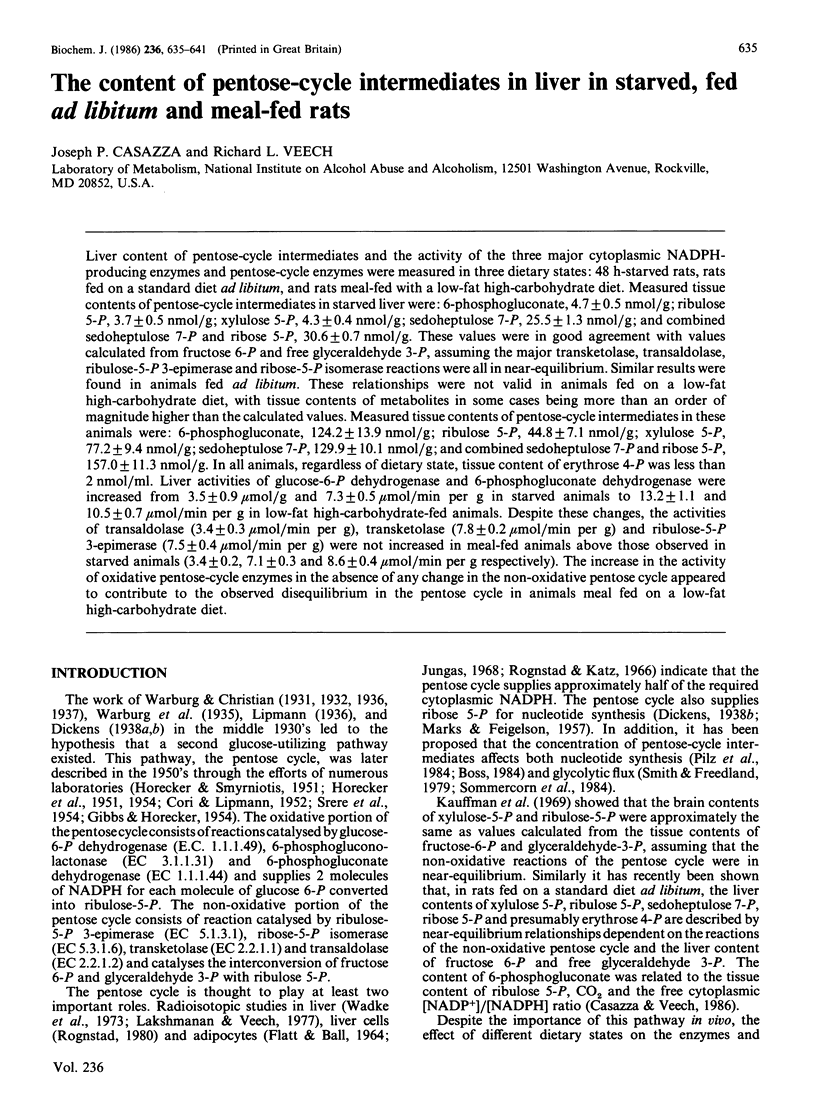
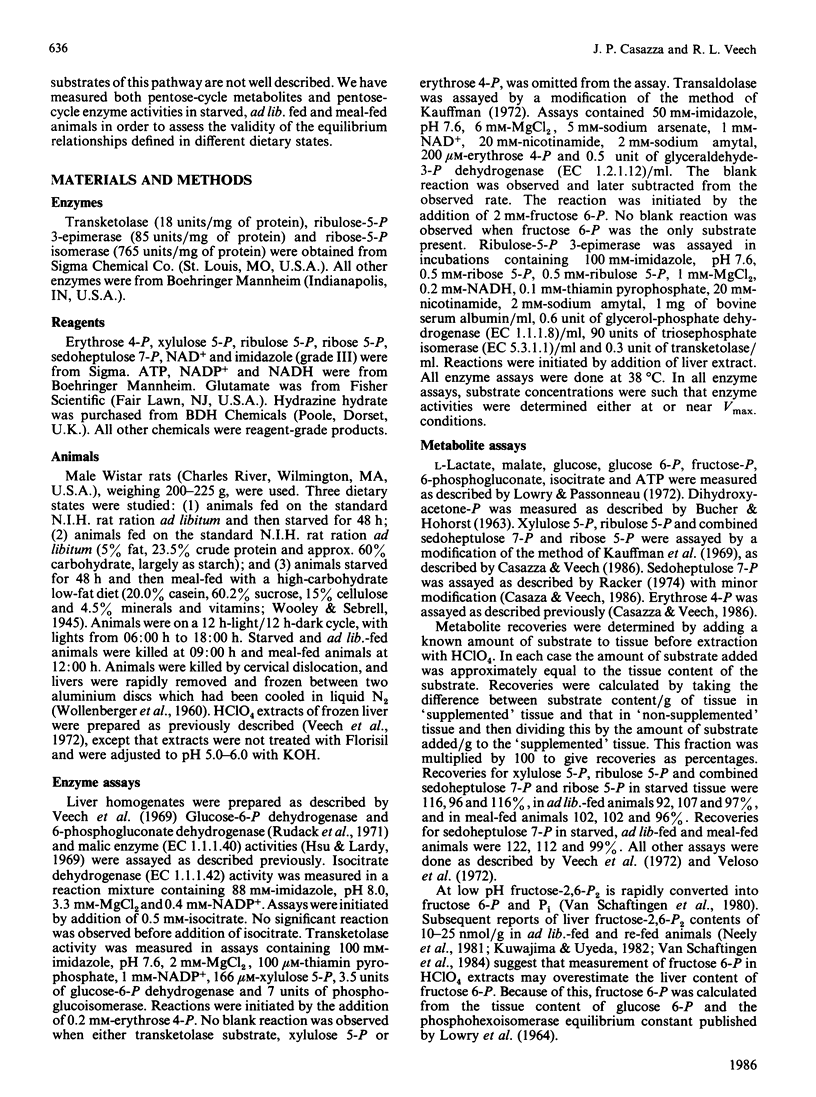
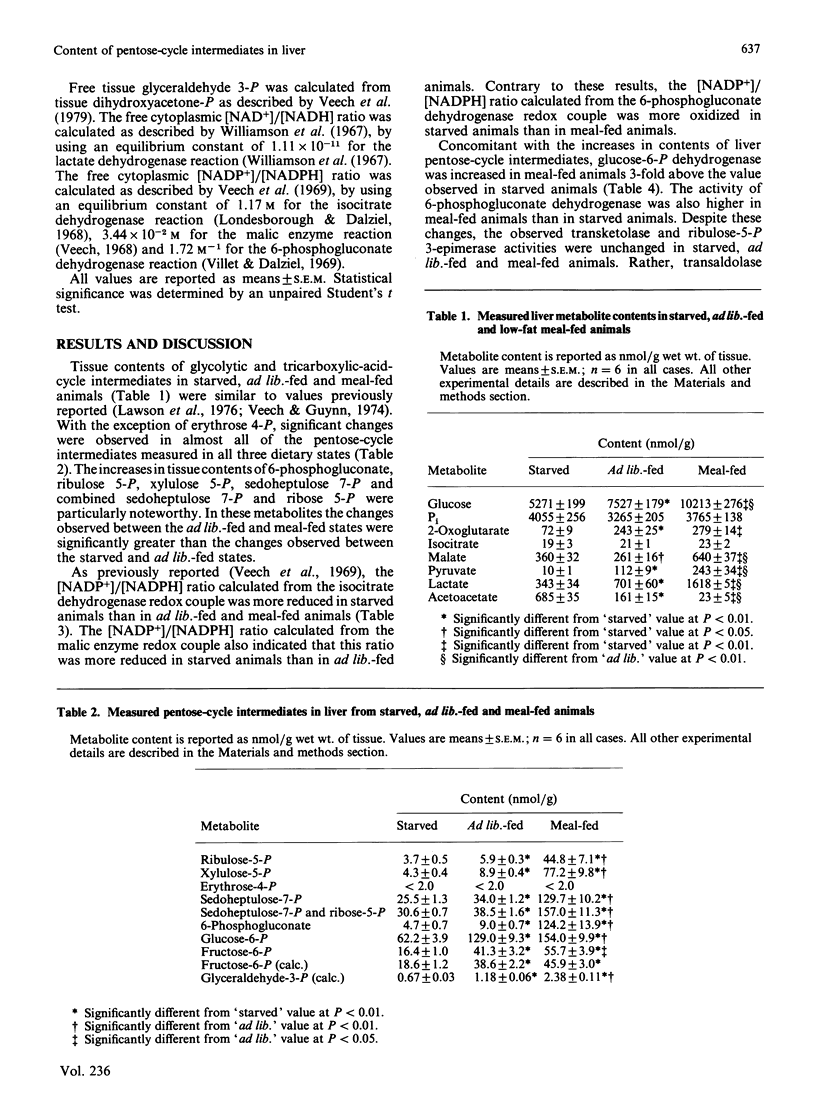
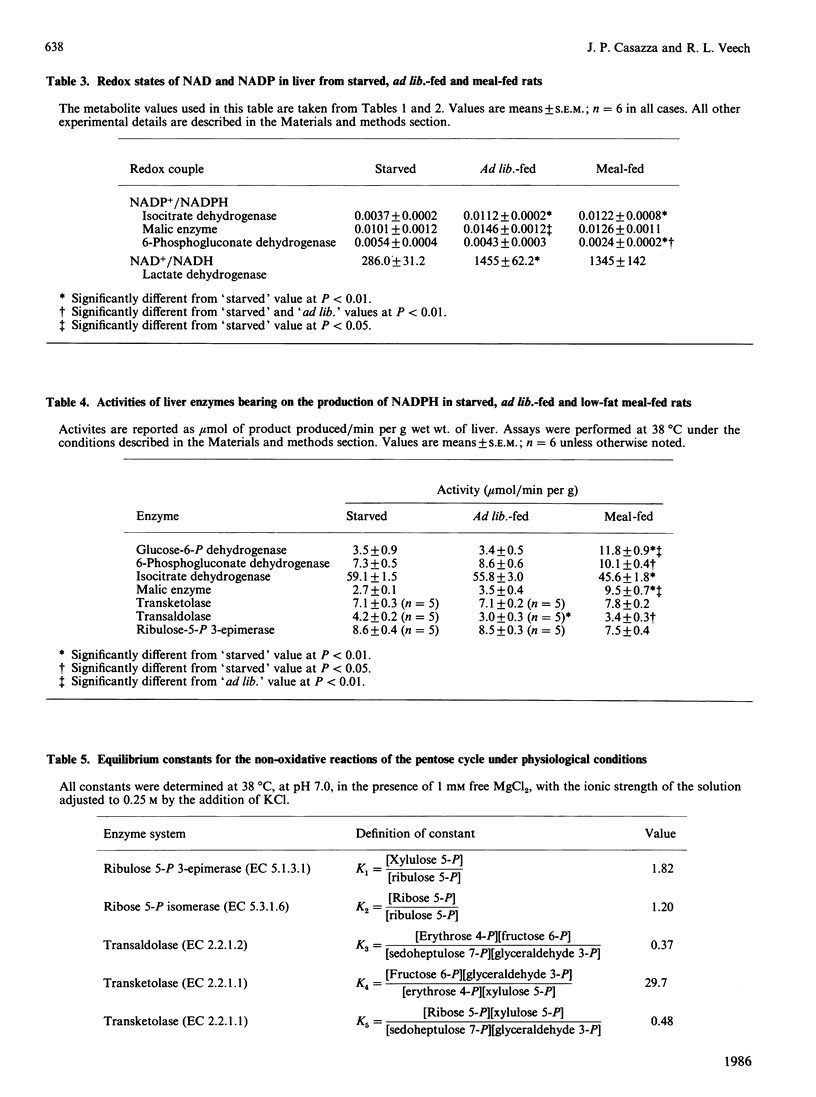
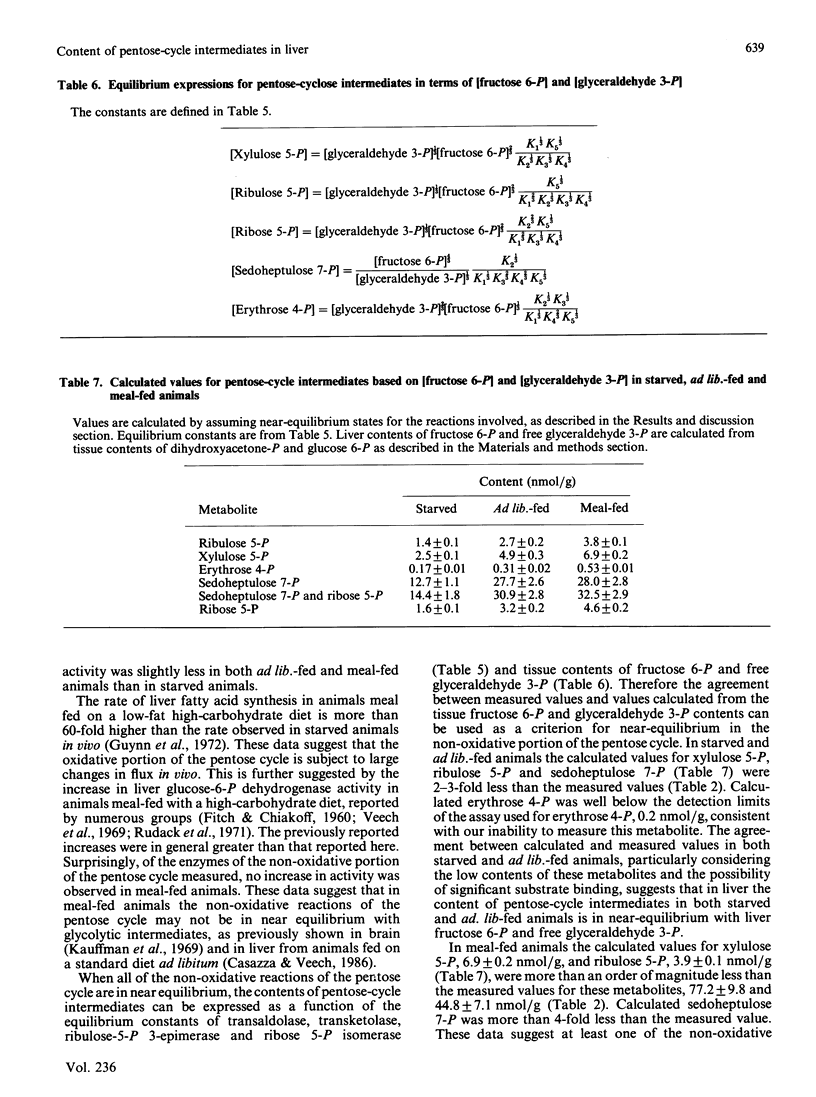
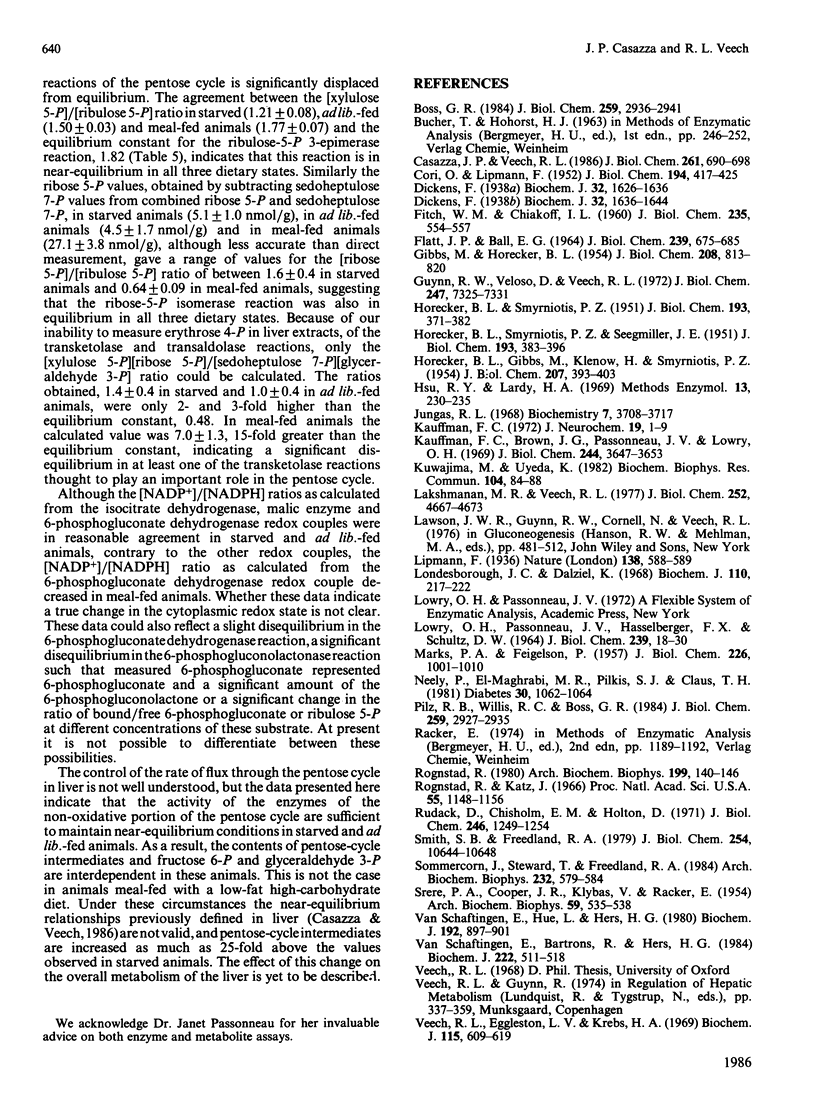
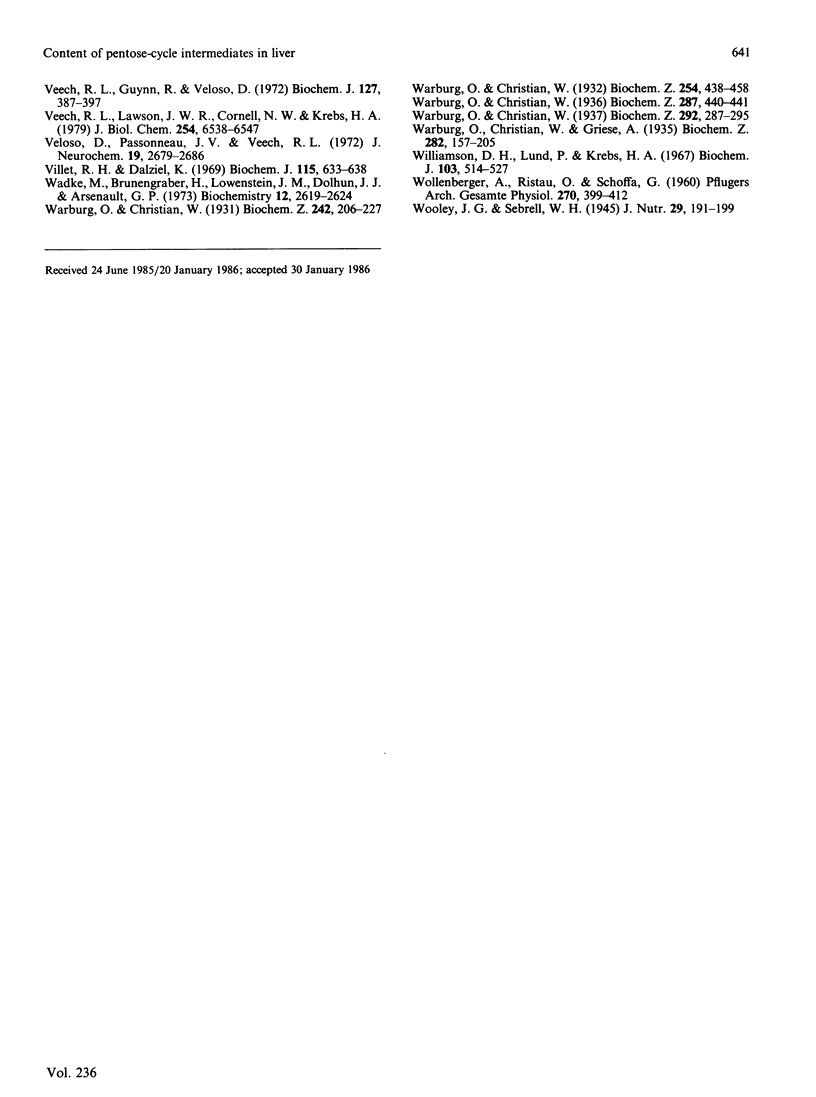
Selected References
These references are in PubMed. This may not be the complete list of references from this article.
- Boss G. R. Decreased phosphoribosylpyrophosphate as the basis for decreased purine synthesis during amino acid starvation of human lymphoblasts. J Biol Chem. 1984 Mar 10;259(5):2936–2941. [PubMed] [Google Scholar]
- CORI O., LIPMANN F. The primary oxidation product of enzymatic glucose-6-phosphate oxidation. J Biol Chem. 1952 Jan;194(1):417–425. [PubMed] [Google Scholar]
- Casazza J. P., Veech R. L. The interdependence of glycolytic and pentose cycle intermediates in ad libitum fed rats. J Biol Chem. 1986 Jan 15;261(2):690–698. [PubMed] [Google Scholar]
- Dickens F. Oxidation of phosphohexonate and pentose phosphoric acids by yeast enzymes: Oxidation of phosphohexonate. II. Oxidation of pentose phosphoric acids. Biochem J. 1938 Sep;32(9):1626–1644. doi: 10.1042/bj0321626. [DOI] [PMC free article] [PubMed] [Google Scholar]
- FITCH W. M., CHAIKOFF I. L. Extent and patterns of adaptation of enzyme activities in livers of normal rats fed diets high in glucose and fructose. J Biol Chem. 1960 Mar;235:554–557. [PubMed] [Google Scholar]
- FLATT J. P., BALL E. G. STUDIES ON THE METABOLISM OF ADIPOSE TISSUE. XV. AN EVALUATION OF THE MAJOR PATHWAYS OF GLUCOSE CATABOLISM AS INFLUENCED BY INSULIN AND EPINEPHRINE. J Biol Chem. 1964 Mar;239:675–685. [PubMed] [Google Scholar]
- GIBBS M., HORECKER B. L. The mechanism of pentose phosphate conversion to hexose monophosphate. II. With pea leaf and pea root preparations. J Biol Chem. 1954 Jun;208(2):813–820. [PubMed] [Google Scholar]
- Guynn R. W., Veloso D., Veech R. L. The concentration of malonyl-coenzyme A and the control of fatty acid synthesis in vivo. J Biol Chem. 1972 Nov 25;247(22):7325–7331. [PubMed] [Google Scholar]
- HORECKER B. L., GIBBS M., KLENOW H., SMYRNIOTIS P. Z. The mechanism of pentose phosphate conversion to hexose monophosphate. I. With a liver enzyme preparation. J Biol Chem. 1954 Mar;207(1):393–403. [PubMed] [Google Scholar]
- HORECKER B. L., SMYRNIOTIS P. Z. Phosphogluconic acid dehydrogenase from yeast. J Biol Chem. 1951 Nov;193(1):371–381. [PubMed] [Google Scholar]
- HORECKER B. L., SMYRNIOTIS P. Z., SEEGMILLER J. E. The enzymatic conversion of 6-phosphogluconate to ribulose-5-phosphate and ribose-5-phosphate. J Biol Chem. 1951 Nov;193(1):383–396. [PubMed] [Google Scholar]
- Jungas R. L. Fatty acid synthesis in adipose tissue incubated in tritiated water. Biochemistry. 1968 Oct;7(10):3708–3717. doi: 10.1021/bi00850a050. [DOI] [PubMed] [Google Scholar]
- Kauffman F. C., Brown J. G., Passonneau J. V., Lowry O. H. Effects of changes in brain metabolism on levels of pentose phosphate pathway intermediates. J Biol Chem. 1969 Jul 10;244(13):3647–3653. [PubMed] [Google Scholar]
- Kauffman F. C. The quantitative histochemistry of enzymes of the pentose phosphate pathway in the central nervous system of the rat. J Neurochem. 1972 Jan;19(1):1–9. doi: 10.1111/j.1471-4159.1972.tb01247.x. [DOI] [PubMed] [Google Scholar]
- Kuwajima M., Uyeda K. The tissue distribution of fructose-2,6-p2 and fructose-6-P,2-kinase in rats and the effect of starvation diabetes and hypoglycemia on hepatic fructose-2,6-P2 and fructose-6-P,2-kinase. Biochem Biophys Res Commun. 1982 Jan 15;104(1):84–88. doi: 10.1016/0006-291x(82)91943-x. [DOI] [PubMed] [Google Scholar]
- LOWRY O. H., PASSONNEAU J. V., HASSELBERGER F. X., SCHULZ D. W. EFFECT OF ISCHEMIA ON KNOWN SUBSTRATES AND COFACTORS OF THE GLYCOLYTIC PATHWAY IN BRAIN. J Biol Chem. 1964 Jan;239:18–30. [PubMed] [Google Scholar]
- Lakshmanan M. R., Veech R. L. Measurement of rate of rat liver sterol synthesis in vivo using tritiated water. J Biol Chem. 1977 Jul 10;252(13):4667–4673. [PubMed] [Google Scholar]
- Londesborough J. C., Dalziel K. The equilibrium constant of the isocitrate dehydrogenase reaction. Biochem J. 1968 Nov;110(2):217–222. doi: 10.1042/bj1100217. [DOI] [PMC free article] [PubMed] [Google Scholar]
- MARKS P. A., FEIGELSON P. The biosynthesis of nucleic acid ribose and of glycogen glucose in the rat. J Biol Chem. 1957 Jun;226(2):1001–1010. [PubMed] [Google Scholar]
- Neely P., El-Maghrabi M. R., Pilkis S. J., Claus T. H. Effect of diabetes, insulin, starvation, and refeeding on the level of rat hepatic fructose 2,6-bisphosphate. Diabetes. 1981 Dec;30(12):1062–1064. doi: 10.2337/diab.30.12.1062. [DOI] [PubMed] [Google Scholar]
- Pilz R. B., Willis R. C., Boss G. R. The influence of ribose 5-phosphate availability on purine synthesis of cultured human lymphoblasts and mitogen-stimulated lymphocytes. J Biol Chem. 1984 Mar 10;259(5):2927–2935. [PubMed] [Google Scholar]
- Rognstad R., Katz J. The balance of pyridine nucleotides and ATP in adipose tissue. Proc Natl Acad Sci U S A. 1966 May;55(5):1148–1156. doi: 10.1073/pnas.55.5.1148. [DOI] [PMC free article] [PubMed] [Google Scholar]
- Rognstad R. Pathways of NADPH in rat liver. Evidence favoring a single cytosolic pool. Arch Biochem Biophys. 1980 Jan;199(1):140–146. doi: 10.1016/0003-9861(80)90266-0. [DOI] [PubMed] [Google Scholar]
- Rudack D., Chisholm E. M., Holten D. Rat liver glucose 6-phosphate dehydrogenase. Regulation by carbohydrate diet and insulin. J Biol Chem. 1971 Mar 10;246(5):1249–1254. [PubMed] [Google Scholar]
- SRERE P. A., COOPER J. R., KLYBAS V., RACKER E. Xylulose-5-phosphate, a new intermediate in the pentose phosphate cycle. Arch Biochem Biophys. 1955 Dec;59(2):535–538. doi: 10.1016/0003-9861(55)90523-3. [DOI] [PubMed] [Google Scholar]
- Smith S. B., Freedland R. A. Activation of pyruvate kinase by 6-phosphogluconate. J Biol Chem. 1979 Nov 10;254(21):10644–10648. [PubMed] [Google Scholar]
- Sommercorn J., Steward T., Freedland R. A. Activation of phosphofructokinase from rat tissues by 6-phosphogluconate and fructose 2,6-bisphosphate. Arch Biochem Biophys. 1984 Aug 1;232(2):579–584. doi: 10.1016/0003-9861(84)90576-9. [DOI] [PubMed] [Google Scholar]
- Van Schaftingen E., Bartrons R., Hers H. G. The mechanism by which ethanol decreases the concentration of fructose 2,6-bisphosphate in the liver. Biochem J. 1984 Sep 1;222(2):511–518. doi: 10.1042/bj2220511. [DOI] [PMC free article] [PubMed] [Google Scholar]
- Van Schaftingen E., Hue L., Hers H. G. Fructose 2,6-bisphosphate, the probably structure of the glucose- and glucagon-sensitive stimulator of phosphofructokinase. Biochem J. 1980 Dec 15;192(3):897–901. doi: 10.1042/bj1920897. [DOI] [PMC free article] [PubMed] [Google Scholar]
- Veech R. L., Eggleston L. V., Krebs H. A. The redox state of free nicotinamide-adenine dinucleotide phosphate in the cytoplasm of rat liver. Biochem J. 1969 Dec;115(4):609–619. doi: 10.1042/bj1150609a. [DOI] [PMC free article] [PubMed] [Google Scholar]
- Veech R. L., Guynn R., Veloso D. The time-course of the effects of ethanol on the redox and phosphorylation states of rat liver. Biochem J. 1972 Apr;127(2):387–397. doi: 10.1042/bj1270387. [DOI] [PMC free article] [PubMed] [Google Scholar]
- Veech R. L., Lawson J. W., Cornell N. W., Krebs H. A. Cytosolic phosphorylation potential. J Biol Chem. 1979 Jul 25;254(14):6538–6547. [PubMed] [Google Scholar]
- Veloso D., Passonneau J. V., Veech R. L. The effects of intoxicating doses of ethanol upon intermediary metabolism in rat brain. J Neurochem. 1972 Nov;19(11):2679–2686. doi: 10.1111/j.1471-4159.1972.tb01327.x. [DOI] [PubMed] [Google Scholar]
- Villet R. H., Dalziel K. The nature of the carbon dioxide substrate and equilibrium constant of the 6-phosphogluconate dehydrogenase reaction. Biochem J. 1969 Dec;115(4):633–638. doi: 10.1042/bj1150633. [DOI] [PMC free article] [PubMed] [Google Scholar]
- WOLLENBERGER A., RISTAU O., SCHOFFA G. [A simple technic for extremely rapid freezing of large pieces of tissue]. Pflugers Arch Gesamte Physiol Menschen Tiere. 1960;270:399–412. [PubMed] [Google Scholar]
- Wadke M., Brunengraber H., Lowenstein J. M., Dolhun J. J., Arsenault G. P. Fatty acid synthesis by liver perfused with deuterated and tritiated water. Biochemistry. 1973 Jul 3;12(14):2619–2624. doi: 10.1021/bi00738a011. [DOI] [PubMed] [Google Scholar]
- Williamson D. H., Lund P., Krebs H. A. The redox state of free nicotinamide-adenine dinucleotide in the cytoplasm and mitochondria of rat liver. Biochem J. 1967 May;103(2):514–527. doi: 10.1042/bj1030514. [DOI] [PMC free article] [PubMed] [Google Scholar]


